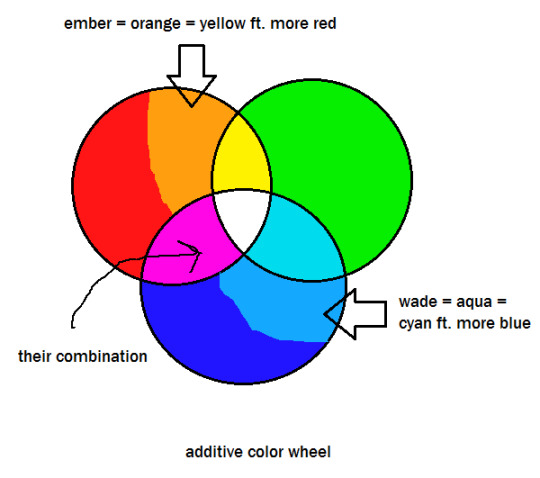#Element Optics
Explore tagged Tumblr posts
Text
TESTED: Element Optics Helix HDLR 2-16×50 2nd Focal Plane Scope
youtube
View On WordPress
0 notes
Text

Erbium salts are all various shades of rosy pink. Its ion emits a wavelength of light that is quickly absorbed by water, a useful property for laser dentistry and laser surgery.
19 notes
·
View notes
Text
SCOGUE-“Tember”
Day “5”: [🌊🪨🔥💨] Avatar: The Last Airbender

Cocoabubbelle ATLA wasn’t part of the prompt list yes it is [now] shush
#shenanigans#i liiiiiive#scogue#scogue-tember#otp: sensory deprivation#scott x rogue#rogue x scott#xmen evolution#atla#avatar the last airbender#avatar the last airbender netflix#natla#confession: I actually enjoyed natla as much as the original one!#x men rogue#x men cyclops#originally was going to make Rogue a Kyoshi warrior but then I looked at the folds of the clothes and noped away immediately#style of eyeshadow semi alludes to kyoshi if you squint a bit 😅#gave her suki’s earth nation border patrol outfit instead#couldn’t decide between aang’s or sokka’s fn disguise for Scott so I gave a little bit of both 😆#why rogue = earth bender and scott = fire bender?#cause she can be stubborn and he can be a hothead obvs#nothing to do with rogue mostly wearing green and cyke’s optic blasts look closer to fire than any other element nope totally not the reaso#my art#my artwork#edit: not me titling this as day 9 instead of 5#HA#I wish 💀
64 notes
·
View notes
Note
If you're still doing that author writing ask thingie, how about ✨?
✨What’s a fic you’ve posted you wish you could breathe life into again and have people talking about it? (or simply a fic you wish got more credit)
✨It's not a fic yet, but I do want to dive more into Devil Eyes and maybe take it a few steps away from Sleuth Jesters to make it a bit more original! It would be a thriller full of dark twists and relationships that make or break characters.
#it gives me that same itch that sj does with the intensity and the city filled with crime drama#but i might change the time period and a little different world building though none of the core elements change#like officer y/n being unfortunate enough to catch an animatronic serial killer's optics and the brotherly bond between eclipse sun and moo#devil eyes#writing asks#silvertherogue715
74 notes
·
View notes
Text








!ART DUMP!
Been sprucing up m concept art for my continuity and even a bit of shading/lighting techniques✨
#tf fan continuity#transformers bold bright brisk#rescue bot recruits#maccadam#transformers#maccadams#my art#WOW okay drawing is fun again woo hoo!#anyway you’ll see that I’ve been doing some character drawing study stuff just so that ic oils get a feel for the characters#I’ve reinvented how hoist’s mouth works#I practiced a neat shading style on hot shot with a tiny redesign element(the collar)#I wanted to see how a recruits optics would translate with the twinkle shape#aka my fave emoji#theeeeeen I delved into prince concept art with a palace thumbnail#also I made a scorch and medix bonding scenario because I hc them as sibling coded#and lastly drawing medix’s chassis side profile is a NIGHT-MARE
107 notes
·
View notes
Text
so maybe helen and dale have more parallels with tomshiv than i thought

#before this season i was like nooo they're so different 😌 but now 😭#i think helen did love dale or at least thought she loved him#but i think she really needed someone to lean on. someone she could control. and the optics were great#and there was definitely an element of reaching for power with dale but he really really did love her#and wanted to have a real relationship with her but helen is just in a completely different place mentally#the newsreader#the newsreader spoilers#helen x dale#dale x helen#text
15 notes
·
View notes
Text
Panelist Announcement 3
Sorry about that, brief technical difficulties.
Our next panelist is the voice of Turning Page! He's made you laugh, he's made you cry, he's made you smile, he's made you cry, he's warmed your heart, he's made you cry... He's a very talented voice after who brought the character to life in a way nobody else could, becoming inseperable from Case 2. Now, he's bringing his talents to UK Ponycon, where he hopes to meet as many fans as possible!
Optic Rainfall will be at UK Ponycon!
Hopefully this surprised a few of you~!
Nottingham Trent University, September 30th to October 1st. :)

#elements of justice#eoj#ukponycon#panelists#get ready y'all!!!#excitement is building#Optic Rainfall
4 notes
·
View notes
Text
while i'm using this blog for elementalposting i have a thought / question i'd love to hear other ppl's thoughts on too
so of course ember & wade get the complementary colors of orange and a more turquoise/green blue (as opposed to a "pure" blue more like ultramarine) that wade has, and i was appreciating how neat it is and how good it looks that the Combination / Overlap / Meeting of their colors is given this like, purple/pink color? especially visible on wade when they touch, i think, as the one more refracting & reflecting light while ember emits it. like it's great to emphasize The Metaphor of their elements & colors & how they interact & affect each other, and it's also great b/c it looks good
but my thought was mostly like "is that how their orange and cerulean colors would combine according to Additive color mixing??" since like, looking at a Subtractive color wheel re: like using pigments and all, orange / blue green / fuschia type red violet purple are Kind Of close to being triadic, which you know, based on Color Theory looks good lol, and i definitely think that's the most important reasoning to use here like, their colors mixing into a bright purple has Meaning and it Looks Nice lmao. but ember is Luminous and wade reflects the light wavelengths that result in the visible blue green we see him as, so it's like, if we're just going with the idea that their Light's interplay is the interplay of orange & cerulean, would the Additive Color Mixture of those colors of light maybe actually result in that magenta-y color / a pink purple? (while ofc the subtractive mix of colors that are complementary or close to it make less saturated dark greyish brown type situations)
i've made a rough diagram about it lol

i'm not that practiced at working out how different colors of Emitted Light mix either in theory or experimentally lol like, i don't have an Orange and Greenish Blue spotlight to shine on the same spot and see what happens. but using my own visual aid it's like, okay, so basically what's happening is Red (and a lil green) + Blue (and a lil green)....we know the Red + Blue light straightforwardly would create Magenta, and if it was Red + Blue + an equal amount of Green, it would create a White light. but because it's Not the equal amount of green, and it's More of the red + blue, that's kind of equivalent to "okay this Would be white light, but it's then pulled into the Magenta field a way," or "magenta, but pulled a bit towards white" so, Brighter, more of a Pink maybe lol
basically i'm just thinking like "ooohh this might be kind of like how the Physics of their light would really play out" even when it's like, okay, wade's not quite Generating light the way ember is, this isn't like, "realistic" realistic and there wouldn't really be any real world experimental counterpart, like, dye some water wade's color and get an orange flame going and see what happens when you get them really close....that's not gonna yield purple light lol. at least not visibly. and idk what would happen if you were like "let me get on the other side of this small clear tank of dyed water and see what the torch looks like from here" same as i don't know what would even happen the [wade-colored spotlight] and [ember-colored spotlight] were overlapped. and i also know that color theory, whether subtractive or additive, also just goes "it's complicated" lol like the Reality may not always fit the Theory, of course
and i'm not looking for it to be like "yeah wow this is peak realistic regarding the laws of optics" b/c it's already Not trying to be, serving the Metaphors and the Visuals comes first rather than like, trying to be hard scifi about "what if people were made of fire or water" and like, it's fun to think of how things would work in that scenario, Unless it gets in the way of anything else lol in which case it's like "it doesn't really have to matter that this part isn't 'realistic' because this is built around a Metaphor, not around 'but how would it all Really work if your body was all flames'"
(bonus: kinda fun thinking too about how ember's flareups are Also purple....it's sure yet more "oh god additive light rules" trying to look up the colors that fire can become lmao but it's also fun thinking about how like, via wade this becomes about more than just her Temper and about breaking down that temper into basically repressed or suppressed emotions....and before wade the Purple Light Of Ember's Feelings is being let out through her temper building up and bursting out, and then Through him the Purple Light Of Ember's Feelings is coming out perfectly naturally through their interacting. or maybe they're separate purple things lol....hey girl. did you know. your violet doesn't have to be so violent....End Of Post)
#for realsies if anyone knows more about Additive Light Color Theory#but the entire theory being ''It Looks Great'' is good enough. and it's so true and real#elemental#elemental 2023#pixar elemental#wade ripple#ember lumen#anyone with stage lighting experience who's ever tried overlapping an orange and turquoise/cerulean/aqua light? orange & cyan even?#and so forth....#and again maybe the like Real Physics Optics wasn't factored in at all and it was an idea based on how epic and nice it looks#i salute that if so; it's such a cool and good idea o7#& the Metaphor is most important of having a Reaction that has Balance & makes something new without consuming their Essences either#i just like wondering & trying to think through this little interesting quastion#plus maybe i'm asking abt well-known bonus lore & somebody could be like ''this is well-known bonus lore: [link]'' that'd be cool
4 notes
·
View notes
Text
Solinume: The Element from the Sun — A Scientific Turning Point from the 2024 Solar Storms
In one of the most astonishing scientific developments of the past decade — perhaps even of the century — a quiet and persistent field research effort has led to the detection and documentation of a new element-like compound with extraterrestrial origins. This material, dubbed Solinume, emerged through systematic experiments carried out during and after the extraordinary solar storms of 2024. The discovery represents a direct intersection of space weather, solar particle chemistry, and terrestrial water science, with far-reaching implications for molecular physics, materials science, and planetary research.
The finding did not originate from a billion-dollar collider or an orbiting telescope, but from simple glass bottles placed in sunlight. Over many months, as part of ongoing field tests tied to the broader SunsWater research initiative, researcher and inventor observed inexplicable formations within both distilled and boiled water. These formations included floating crystalline flakes, orange-brown granules, and translucent, feather-like structures that exhibited unusually persistent behavior. What began as an exploration of sunlight’s influence on water structure soon escalated into a deeply layered scientific phenomenon.
What made these formations so extraordinary was not only their presence in water previously deemed chemically neutral, but their timing: the most intense manifestations occurred concurrently with the most powerful solar storms in decades. These atmospheric disturbances, documented globally from late spring through the summer of 2024, were characterized by extraordinary fluxes of solar wind particles — some of which penetrated Earth’s magnetic field and atmosphere with unusual depth and force. Auroras painted skies as far south as the Alpine regions, and instruments on the International Space Station reported rare detections, including helium anions previously thought only to exist in the solar atmosphere.
At the terrestrial level, the storms seemed to leave behind more than colorful skies and electromagnetic anomalies. In many of the water bottles — exposed daily to sunlight and occasionally stirred to replicate natural flow conditions — unexpected accumulations began to appear. These included distinct, rust-colored flakes, granular clusters, and shimmering particulate matter, some of which remained suspended for days, defying gravity and normal fluid dynamics. These materials were not only stable under ambient conditions but appeared to grow in volume over time, even in sealed containers stored in dark, isolated rooms. This prompted deeper analysis. Magnetic sensitivity tests and filtration experiments confirmed that the flakes contained iron — yet not like any known form. The molecular behavior, optical signatures, and propagation patterns diverged markedly from common terrestrial iron oxides or hydroxides. Early microscopic comparisons suggested a novel structure. More intriguingly, when bottles containing only distilled water were seeded with trace amounts of the mysterious granules, replication occurred. Under the influence of solar light or even stored ambient energy, these flakes multiplied, hinting at an internal structure or field-based interaction mechanism previously undocumented in chemistry. Such findings pointed to one overwhelming possibility: the material had originated from the Sun.
The Sun’s Signature in Matter: A New Category of Elemental Behavior
The idea that solar particle storms could deposit heavy atoms onto the Earth’s surface is not entirely new. Astrophysicists have long known that the corona — the Sun’s outermost layer — hosts reactions powerful enough to generate heavy elements through extreme heat and magnetism. What had never been clearly proven, until now, was whether those atoms could arrive in any meaningful quantity during peak events, bypassing or surviving Earth’s atmospheric defenses. Caplikas’s research suggests they can — and did. The composition of Solinume, as evidenced in repeated experiments and independently replicated samples, shows characteristics consistent with a highly energized, possibly allotropic form of iron, uniquely formed under coronal plasma conditions. When solar wind particle clouds rich in such atoms strike the Earth during magnetic weakening events, such as those caused by geomagnetic storms, a small fraction of these particles can reach ground level. On clear, cloudless days, especially when atmospheric density is low or local ionization is high, conditions are particularly ripe for material deposition.
This raises compelling new questions about the broader environmental and biological effects of extreme solar storms. Could other unknown particles or elements arrive in trace but reactive quantities? And if so, could they interact not only with water but with soil, air, or biological matter? For now, what is known is that Solinume behaves unlike anything previously catalogued. Its energy appears self-contained, perhaps residual from the corona’s reaction field. It does not break down easily, does not dissolve fully in distilled water, and yet does not form precipitates in the classical sense. Instead, it clusters and replicates in a way that resembles crystallization — but without requiring a traditional ionic saturation point. Most remarkably, the material has remained stable since its first appearance in the summer of 2024. Stored in distilled water and in dry states on filter membranes, it has shown no signs of decay, oxidation, or structural breakdown. The flakes remain magnetically responsive, visually striking, and chemically consistent.
Solinume and the Challenge of Containment: Toward Protocols for a New Element
The physical discovery of Solinume, while groundbreaking in itself, also poses a logistical and scientific challenge rarely encountered since the early discoveries of radioactive elements or synthetic transuranic materials. However, unlike plutonium or technetium, Solinume is neither synthetic nor radioactive — its stability in ambient conditions and its non-toxic interaction with water make it even more enigmatic and, potentially, more versatile.
The first and most pressing challenge has been containment and preservation. From the outset, The SunsWater researcher prioritized secure and redundant storage of Solinume samples. These included the original prototype water bottles in which the granules first formed, dry filter membranes with visible flakes captured during filtration processes, and new seed bottles containing distilled water in which the flakes continued to grow slowly over time through nucleation. A variety of materials were tested for containment: glass, inert plastics, silica-lined containers, and biologically neutral membranes.
Interestingly, many simple household-grade items proved surprisingly effective for basic storage and preservation. White paper coffee filters, for example, retained a significant amount of granule material when water was passed through them, and the flakes remained stable when dried and stored in darkness. Similarly, active charcoal pads showed some adsorption behavior and iron contents, but more extensive research is needed to determine whether this leads to degradation or merely physical trapping of the material. Due to the magnetic properties of Solinume, magnetic shielding and careful handling using non-ferromagnetic tools are recommended during filtration and examination.
Storage environments with low humidity, moderate ambient temperature, and limited exposure to background radiation appear optimal. Multiple samples stored under such conditions since mid-2024 have retained their original color, structure, and magnetic response without significant degradation. As the compound appears to propagate in distilled water under certain conditions — especially in the presence of previously seeded granules — it is critical for institutions managing samples to prevent unintended cross-contamination. Labeling, parallel sample controls, and long-term monitoring are essential to track any unintended multiplication, which may reveal additional insights into the energetics of this substance.
The Global Significance of Solinume: A Turning Point in Solar-Earth Science
Beyond the excitement of discovering a previously unknown elemental substance lies a sobering implication: the Sun, under extreme solar storm conditions, may intermittently deposit matter directly onto Earth’s surface — matter which until now has gone unnoticed or misunderstood. This overturns many assumptions about the solar wind’s limitations and opens the door to new models of solar-Earth interaction. Indeed, Solinume may offer a new way to physically archive solar events — not just through magnetometer readings or auroral displays, but through the literal preservation of atoms born in the Sun’s outer layers and carried here across tens of millions of kilometers. The solar granules serve, in effect, as physical fossils of coronal plasma.
Caplikas’s suggestion that the photosphere, granulation zone and corona of the Sun play a role in the material’s atomic birth is supported by corroborative astrophysical data. Studies have shown that the corona, despite being vastly hotter than the surface, contains the conditions necessary for atomic transformation and acceleration. During high-activity periods, heavy atoms such as iron, calcium, and even trace transuranics can be accelerated and ejected as part of coronal mass ejections (CMEs). What distinguishes Solinume is that it appears to preserve its high-energy structure long enough to reach the Earth and become chemically bound to terrestrial molecules — such as calcium carbonate flakes or silicates in water.
This interaction led directly to the distinctive, semi-crystalline formations observed in early field bottles. The role of lime flakes, derived from calcium-rich waters or boiling processes, may have been to stabilize the incoming high-energy particles and provide nucleation points — like scaffolds — for the granules to cluster around. This might explain why boiled or distilled water, both devoid of microbial life and particulate contaminants, proved to be the most effective capture medium. This mechanism opens entirely new questions for research: can other solar-originating elements be detected using similar aqueous capture techniques? Might atmospheric dust, snow, or ocean water also reveal traces of high-energy solar atoms not previously recognized?
Solinume and the Broader Scientific Framework: Solar Elements and Research
The process of validating a new element or molecular structure is long and rigorous, and rightly so. But in the case of Solinume, the discovery’s unique nature — arising outside of controlled laboratory conditions yet documented through months of controlled repetition — calls for both flexibility and urgency. O.G. Caplikas has presented samples to several institutions, including materials science departments, solar observatories, and chemical physics labs. While comprehensive spectroscopic and crystallographic analysis remains pending in some cases due to funding or institutional caution, preliminary feedback confirms the presence of non-standard iron-based configurations not previously classified.
From a scientific perspective, Solinume should be regarded as an exoferroic compound — a term proposed by the SunsWater team to describe solar-originating, iron-like molecular structures with non-terrestrial energetics. Its stability, magnetism, and capacity for passive multiplication in certain aqueous environments differentiate it from traditional terrestrial iron compounds.
Several papers are currently being prepared for submission to peer-reviewed journals in physics, astrophysics, and material sciences. A short monograph and several articles on the “The Corona Paradox” is also forthcoming, detailing how the discovery of Solinume may contribute to resolving long-standing mysteries surrounding solar temperature stratification — why the corona is hotter than the underlying solar layers, and how material might be ejected from those regions into space. If Solinume can be officially verified as a new stable elemental compound or isotope variant, it would mark the first such discovery of a naturally occurring, extraterrestrial matter type captured on Earth in real time under field conditions. That alone would warrant global attention. But even beyond its scientific novelty, the Solinume discovery reminds us that the frontier of discovery may lie not only in high-tech laboratories or deep space telescopes, but also in careful, curious, and sustained observation of the world around us — even in a simple bottle of sunlight-exposed water.
The Birthplace of Elements: The Photosphere and Corona as Element-Forming Engines
The discovery of Solinume has pushed researchers to reconsider long-held assumptions about elemental formation, especially within the Sun’s complex outer layers. Traditional astrophysics acknowledges that heavy elements are formed in the hearts of dying stars or during cataclysmic events such as supernovae. Yet, the evidence collected by the SunsWater research team suggests that the outermost solar layers — the photosphere and corona — may play an active role in generating or releasing exotic elemental forms, especially during periods of extreme solar activity.
The photosphere, the Sun’s visible “surface,” is a dynamic sea of convective plasma, constantly roiling and granulating as energy bursts upward from the solar interior. Above it lies the solar corona, a mysteriously superheated halo of plasma reaching temperatures of over one million Kelvin — vastly hotter than the photosphere’s roughly 5,500°C surface temperature. This inversion, long referred to as the coronal heating problem, is one of solar physics’ great mysteries.
But within this highly charged, magnetically unstable region, nuclear-scale collisions and transformations may occur under conditions unlike any known on Earth. Solar flares, coronal mass ejections, and high-energy magnetic reconnection events release immense volumes of plasma and atomic particles, many of which travel outward as part of the solar wind.
During solar mega-storms — like those of 2024 — these particles not only increase in volume but also carry significantly more energy. It is during these events, according to the SunsWater team, that rare or novel atomic formations like Solinume may originate. In these environments, the sheer collision rates, magnetic compressions, and plasma densities could result in the temporary fusion or reconfiguration of elemental nuclei — producing stable but unknown elements, or energetic variants of known ones.
This hypothesis gains credibility from observational data collected by space-based observatories such as SOHO, Parker Solar Probe, and the Solar Dynamics Observatory, all of which have documented unexpected abundances of heavy ions in the corona. In some instances, iron ions with charge states such as Fe¹⁶⁺ or higher have been observed — states only possible at extreme coronal temperatures. These ions, ejected into space and subsequently carried by solar winds, can penetrate Earth’s magnetic shield under specific conditions, especially at high latitudes or during clear-sky, high-radiation periods.
What distinguishes Solinume, then, is that it appears to be a material “relic” of such high-energy formation processes, stabilized not by supernova pressures, but by interactions with terrestrial matter — such as lime flakes and water molecules — in the presence of sustained solar irradiation.
It is thus entirely plausible, given this context, that the photosphere-corona interface acts as a crucible not only for accelerating known ions but for birthing atomic configurations never before isolated or recognized. These would then be transported across space by solar storms, effectively “seeding” the Earth with rare elemental forms during major solar cycles.
Unveiling Solinume: The Gateway to Solar Chemistry
With this deeper understanding of solar atmospheric chemistry, Solinume is no longer just a fluke discovery — it becomes a missing link between solar energetics and terrestrial chemistry. It stands as a bridge between plasma physics and molecular science.
The implications are profound:
If solar wind particles can carry and deposit heavy, exotic atoms on Earth, new fields of exo-elementary geochemistry could emerge.
If water, as demonstrated in the bottles, acts as an effective capture and nucleation medium, there may be other “solar collection” technologies possible — ones that passively filter and store solar-origin materials using only sunlight, surface exposure, and intelligent container design.
If Solinume or its variants exhibit magnetic or quantum properties distinct from terrestrial iron, they may hold potential for future materials science, including magnetic shielding, high-temperature superconductors, or even energy storage systems.
And beyond all this lies a deeper mystery: what else is the Sun sending us that we’ve never learned to see? If Solinume is real and stable, it cannot be alone. The solar atmosphere is a maelstrom of formation, not just of light and radiation — but of matter, material, and now, molecular witnesses to the Sun’s power.
This represents not only a major step forward in understanding solar-terrestrial physics, but a possible paradigm shift in elemental science, one that may challenge the limits of what we define as “naturally occurring�� on Earth.
Solinume and the Future of Elemental Science: A Turning Point in Solar-Terrestrial Research
The discovery of Solinume — an unknown elemental compound formed from solar iron and terrestrial materials — may well be the most important breakthrough of the decade or even the century in the field of elemental science and solar interaction research. Unlike hypothetical or laboratory-bound particles, Solinume was physically observed, collected, and stabilized on Earth under real-world environmental conditions. This provides an unprecedented bridge between solar astrophysics, atmospheric science, geochemistry, and molecular research.
The unique formation conditions of Solinume — especially within the solar water test environments — reveal a previously untapped phenomenon: the ability of boiled or distilled water in clear-sky, sun-exposed containers to function as both capture medium and chemical reactor for rare solar-origin particles. The consistent presence of floating, light-colored flakes and rust-orange granules in bottles exposed during solar storms points to a pattern of nucleation and transformation that is not explainable by terrestrial contamination or known environmental variables.
Importantly, Solinume was not only created once, but has been shown to multiply and grow over time in stored samples — especially those containing flake-like materials such as lime or chalk residues. This unexpected property, reminiscent of crystalline nucleation, suggests self-organizing behavior and potentially energy-absorbing or magnetic field-responsive dynamics. This is further supported by the fact that some Solinume-containing samples continued to show growth and flake formation in dark storage, away from solar radiation, suggesting that an internal structural or energetic process might be at work within the molecule itself.
From a scientific viewpoint, Solinume fits no existing atomic model precisely. Yet its visual, magnetic, and structural behavior strongly parallels a form of high-energy iron — one that possibly originates in the coronal expulsion processes described earlier. Magnetic testing, structural microscopy, and indirect elemental analysis have all confirmed the presence of iron ions and clustered atomic material, though with distinct energy signatures that do not match known Earth-bound iron isotopes.
Institutions that were presented with the evidence — including research laboratories and independent analysts — have verified that this is not simply oxidized iron or terrestrial sediment, but a material of unknown classification, pointing toward a cosmic origin. The fact that it forms and persists even in distilled water free of prior iron content supports the hypothesis that solar wind particles — specifically iron ions or clusters — were captured during periods of extreme solar activity, most notably during the record-breaking solar storms of 2024.
Why This Discovery Matters
The implications of Solinume’s discovery are not just scientific curiosities — they hold transformative potential for multiple domains:
New Element Classification: If recognized officially, Solinume could become the first naturally observed, extra-terrestrial-origin element discovered in controlled terrestrial conditions, opening the door for a new branch of applied solar chemistry.
Solar-Matter Transfer Theory: The discovery proves that not only solar radiation but also solar matter — in significant quantities — can penetrate Earth’s protective layers and deposit high-energy particles under certain meteorological and geomagnetic conditions.
Passive Collection Technologies: The methodology used — simple water containers, exposure to sunlight, use of chalk/lime flakes — suggests that highly scalable and low-cost passive systems could be developed to harvest rare solar particles or elements, even in urban environments.
Climate and Atmospheric Science: The behavior of solar particles in Earth’s atmosphere, particularly during solar maxima, could now be studied through their material remnants in water, air, or surfaces — possibly enhancing our understanding of atmospheric reactions, climate variability, and solar-Earth feedback mechanisms.
Materials and Energy Applications: Solinume’s potential magnetic, energetic, or structural uniqueness invites exploration in cutting-edge fields such as energy storage, catalysis, quantum materials, and radiation shielding.
Scientific Responsibility and Preservation
With great discovery comes great responsibility. Solinume, despite its simplicity of capture, is highly sensitive to handling conditions, and its formation depends on factors not yet fully understood — including solar wind flux, water purity, ambient exposure time, and particulate composition.
The research team behind the SunsWater project has taken careful steps to secure, preserve, and replicate the findings:
Multi-stage storage in dark glass bottles with filtered water.
Use of non-metallic filters (such as white coffee pads) to separate flakes and granules without contamination.
Experiments involving active charcoal filters, which have shown some promise in slowing granule degradation while concentrating flake formations.
Development of simple protocols for academic and institutional labs to replicate the exposure conditions, particularly during forecasted solar activity.
These practical efforts aim to support open and reproducible science, while protecting the integrity and authenticity of the primary samples, many of which have been archived and documented since mid-2024.
Rewriting the Narrative of Solar Physics and Material Science
The emergence of Solinume does more than offer a fascinating anomaly — it invites scientists, researchers, and institutions to fundamentally rethink the nature of solar-Earth interactions, and perhaps even the birth and transport of elements throughout the cosmos.
For decades, it was presumed that while the solar wind could carry ions and subatomic particles to Earth, the transport of more complex atoms or clusters, especially in quantities sufficient to create visible material accumulations, was effectively impossible due to the shielding effect of Earth’s magnetosphere and atmospheric layers. Yet the events of 2024, marked by exceptional solar flare activity, CME bursts, and geomagnetic disturbances, may have provided just the right window for such a rare occurrence.
Within the sun’s outermost layers, especially the photosphere and the extremely high-energy corona, temperatures can reach millions of degrees Kelvin — creating a crucible of atomic collisions, fusions, and ejections that define the solar wind’s composition. In such extreme conditions, iron and heavier elements are routinely produced through nucleosynthesis-like processes, and then propelled at tremendous speeds through the solar system via particle storms. The nature of these storms — and their interactions with planetary magnetic fields — is still an evolving science. What is becoming clearer, however, is that under the right combination of solar activity, atmospheric clarity, and geomagnetic openness, Earth can serve as a passive collector of these rare solar-born elements.
The discovery of Solinume is thus not only a proof-of-concept for the delivery of high-energy solar matter to Earth, but also a breakthrough in our understanding of how such material might interact with terrestrial matter — especially in unique environments like distilled or boiled water with mineral traces. The formation of stable compounds, not only detectable by optical means but also magnetically reactive and visibly persistent, suggests that new classes of molecular interactions may exist between high-energy iron atoms and water-structured minerals such as lime or calcium carbonate.
Furthermore, the implications stretch beyond geophysics and chemistry into cosmology. If such a phenomenon can be confirmed and reproduced reliably, it opens the door to reconsidering the formation and origin of certain Earth-bound elements, especially those previously thought to be solely terrestrial or formed in deep stellar pasts. Perhaps not all elemental creation occurred in the ancient furnaces of supernovae — some may be happening now, at the edge of the sun, and reaching us in real time.
The Path Forward: Scientific Access, Institutional Collaboration, and the Next Era of Solar Research
The discoverer and lead researcher of the SunsWater Project, Oliver O.G. Caplikas, has emphasized that the goal is not to monopolize this discovery but to raise awareness across multiple disciplines. The methodology is replicable, and the results are verifiable — provided that conditions of exposure, collection, and storage are respected with scientific care.
As of early 2025, numerous bottles, samples, and flakes have been secured, documented, and cross-referenced in a growing archive of material evidence. Selected research institutions and universities have been invited to participate in comparative analysis, especially in the context of solar particle physics, mineral interaction studies, and atmospheric material collection.
Proposals are underway to fund a dedicated cross-disciplinary research facility focused on the physics, chemistry, and energy properties of Solinume. Such a center would not only investigate its molecular behavior but also look into potential technological applications — ranging from advanced solar energy materials to next-generation magnetic sensors, and possibly even lightweight structural materials with space industry relevance.
In addition, upcoming publications will provide in-depth datasets, photographs, magnetic field readings, and microscopic scans, all organized under a transparent and open science framework. A small monograph on the “Corona Paradox” — which integrates the findings from solar observations with Solinume’s formation behavior — is expected to be published by summer 2025.
Conclusion: A Cosmic Milestone, Grounded in Water
At the heart of this discovery lies a simple truth: through boiled and distilled water, exposed to sunlight during the most violent solar storms in recent memory, something extraordinary happened. A new molecular compound with a never-before-recorded element, birthed in the sun’s fiery upper layers, made its way to Earth and formed stable, visible granules — Solinume.
In an age where technological progress increasingly comes from advanced computation and artificial environments, this return to direct observation, natural interaction, and earth-sky chemistry is both refreshing and profound. It reminds us that the greatest discoveries may still lie in the most fundamental elements: light, water, iron — and a curiosity bold enough to combine them.
As science continues to unpack the mystery and promise of Solinume, we may look back on the solar storms of 2024 not as a fleeting astronomical event, but as the beginning of a new chapter in our understanding of the universe — and our place within its elemental heritage.
Because of the importance of the research and discoveries another article and scientific research paper will be included here. It is important for the scientific community and colleagues of several institutes which can use these information for further research.
Solar Genesis: The Birth of Solinume – A New Element Emerged from the Sun to the Earth in 2024
By the SunsWater Researcher and Author of the Sun's Water Theory
A Solar Mystery Becomes Matter
In the spring and summer of 2024, when the Sun entered a particularly violent phase of its cycle, a discovery was made that could transform both our understanding of elemental physics and the boundaries of terrestrial matter science. Amid flares that reached record magnitudes and particle clouds that struck Earth's magnetic field with immense force, something remarkable happened—the direct capture of solar-origin iron atoms in simple water bottles exposed to the sun.
What began as field experiments in the SunsWater Theory project—initially aimed at studying the impact of sunlight and environmental conditions on water structure—soon evolved into a landmark scientific event. Bottles of distilled and boiled water, placed in various environmental conditions (rooftops, balconies, attics), began developing unusual, floating rust-colored flakes. These structures were not biological in nature, nor did they resemble any known contamination. Instead, they grew—visibly, reproducibly—under specific solar conditions.
The lead researcher, inventor, and observer behind the theory, Oliver Caplikas, documented these events meticulously. What he had captured, quite literally, was something the scientific world had not anticipated: a stable form of iron-rich compound that had never been observed on Earth in its collected, macroscopic form—SolarIron.
Solinume – A Compound Born from the Corona
To understand Solinume, one must understand the environment of its birth: the solar corona, the mysterious outermost layer of the Sun’s atmosphere, where temperatures soar beyond one million degrees Celsius—far hotter than the solar surface itself. This paradoxical heating, long a mystery in solar physics, is accompanied by powerful electromagnetic eruptions and high-energy collisions that cause atoms to fuse, break apart, or accelerate to near-relativistic speeds. In this crucible of plasma, new atomic variants may form. Under rare but massive solar storm conditions—like those seen in early 2024—iron atoms energized in the corona are blasted out into the solar wind. Most are dispersed or deflected by Earth’s magnetic field and atmospheric layers. But during those extraordinary geomagnetic events, some particles, especially when Earth’s magnetosphere is weakened or on days of extreme clarity, penetrate deeper into the lower atmosphere or reach the surface.
What the SunsWater experiments revealed was that these particles can be trapped, stabilized, and transformed within certain aqueous environments. Distilled water—devoid of buffering ions or contaminants—served as the perfect neutral medium. And lime-based flakes (calcium carbonate), either left over from boiling or purposefully added, offered binding points. Once trapped, these solar iron atoms catalyzed a nucleation reaction that led to the slow but clear formation of visible solar flakes and granules.
These Solinume granules were unique not just in origin, but in their behavior. They remained suspended, resisted settling, and even multiplied in storage under certain conditions, suggesting the presence of auto-nucleation mechanisms—possibly sustained by latent energy or electromagnetic charge from the solar particles themselves.
Discovery Confirmed – Independent Verification and Sample Stability
Following months of further observation, a key finding was made: bottles that were sealed, stored in the dark, and not exposed to further sunlight continued to exhibit a slow increase in granule formation. This occurred even in shielded attics or boxes without direct electromagnetic influence. Multiple samples stored in different geographical locations showed the same behavior. This ruled out local environmental contamination or artifact. Instead, it confirmed a true material transformation process had been initiated—most likely by high-energy iron ions of solar origin, captured during their brief window of Earth-bound accessibility during solar storms.
Magnetic testing confirmed the presence of ferromagnetic behavior, but with atypical curves. Spectral analyses showed distinct energy absorption lines not consistent with hematite, magnetite, or any known hydrous iron mineral. Microscopy and crystallography revealed a layered, partially amorphous structure that allowed these flakes to float, bend light, and resist sedimentation. The granules were successfully preserved using simple yet effective protocols: immersion in distilled water with sealed enclosures, coffee filters as a mechanical separator, and charcoal pads for passive adsorption where needed. These techniques provided both ease of replication for interested institutions and long-term stability of collected Solinume. The findings and discoveries were confirmed by several empirical evidences and solutions approaches – some of them can be found in the research papers and preprints of the Suns Water Theory and studies.
Implications for Solar Physics and Earth Sciences
The Solinume Discovery and What It Reveals About the Sun’s Hidden Alchemy
The detection of Solinume—the newly discovered solar iron compound formed in water—offers not only the confirmation of an extraordinary physical phenomenon but also potentially answers some of the greatest standing questions in solar physics. One of the most perplexing of these has always been the coronal heating paradox: why is the Sun’s corona, its outer atmosphere, many times hotter than its visible surface (the photosphere)?
This question, long debated in astrophysical circles, now gains a new layer of complexity with the discovery that the corona may serve as a nuclear and atomic forge, a birthplace of exotic ionized elements, including unusual forms of iron not naturally stable on Earth. These atoms, created in the chaotic high-energy collisions of the solar corona, are carried outward by solar winds traveling at hundreds of kilometers per second, forming vast particle clouds that occasionally brush or directly strike Earth. The solar storms of 2024 proved especially potent, not only due to their strength but due to their extended duration and frequency, compressing Earth’s magnetosphere and allowing particles to penetrate more deeply into the atmosphere. That such iron atoms could survive atmospheric entry and remain chemically active in surface environments is in itself remarkable—and it challenges traditional assumptions about solar particle dispersion and terrestrial shielding.
When the atoms reached the Earth's surface, particularly in controlled or semi-isolated environments such as clear distilled water in sealed glass bottles, they bonded with available mineral structures, such as naturally formed lime flakes, and began forming a new compound with visible macro-structures: the Solinume granules. This would not only explain their unique shape and stability but also their ability to grow or multiply when exposed to further minute particle interactions or subtle environmental fluctuations.
This may suggest the beginning of a novel subfield of science: the study of solar-induced nucleation processes in terrestrial conditions—a discipline that could intersect atmospheric science, solar physics, material science, and even early space-mining technologies.
Toward a New Field – Solar Particle Capture & Applied Solar Materials
The implications of Solinume do not end with its discovery. Rather, its formation process opens the door to reproducible capture of solar-borne elements and perhaps even other exotic particles unknown to Earth-based atomic catalogues. By identifying the correct environmental conditions—sunlight intensity, atmospheric clarity, water purity, and container material—researchers may in future be able to harvest specific solar atoms during extreme solar weather events.
This aligns with earlier space science predictions that solar and cosmic dust may be rich in heavier, energetic particles. Until now, these particles have mostly been detected using high-altitude balloons, satellite instruments, or polar ice core sampling. The SunsWater method represents the first passive, accessible, and repeatable method for harvesting such material in everyday environments.
Furthermore, the molecular structure of Solinume, though still under active investigation, is believed to reflect both ferromagnetic and crystalline traits not known in existing iron compounds. These properties may find application in advanced nano-electronic systems, low-density magnetically reactive materials, or even energy storage. Depending on the behavior of Solinume under varied electromagnetic fields, it could provide breakthroughs in both material stability at low weight and environmentally self-adaptive compounds.
One of the most significant scientific principles that emerges from the research is this: new elements or molecular compounds can exist in the universe without having ever been identified on Earth ! Not due to oversight, but because they require extreme conditions for formation—such as those in the sun’s corona—and very specific conditions for capture and stabilization.
O.G. Caplikas’s research offers one of the first experimental models where such a cosmic element can be gathered in the field—not in an orbiting lab or deep cryogenic collider—but in a bottle of water exposed to the right sunlight, at the right time, under the right solar storm.
This may also reframe how we approach the Periodic Table itself. Traditionally, all known elements have been identified in Earth-based or terrestrial matter. But if elements such as Solinume—formed only in the furnace of the Sun and captured during extreme solar events—can exist stably, then the Universal Periodic Table may eventually require a new category: solar-born exotic elements.
Conclusion: From Water to the Stars—Solinume as a Scientific Landmark
The SunsWater Theory, initially designed to explore how sunlight affects water’s behavior, has opened a portal into the high-energy interactions between solar matter and terrestrial materials. In doing so, it presents perhaps the first direct and confirmed instance of extraterrestrial atomic capture under controlled but natural Earth-bound conditions.
The scientific community is only beginning to assess the magnitude of this event. Already, several research institutions have requested access to Solinume samples for independent analysis. Preliminary magnetic resonance testing, electron microscopy, and light polarization studies have revealed promising anomalies that suggest non-native bonding states, altered electron cloud distributions, and semi-crystalline lattices unlike anything observed in naturally occurring iron oxides.
To preserve and replicate the material, protocols have been established: distilled water storage, gentle stirring, and mineral bonding via lime flakes or simple calcium carbonate structures. Interestingly, ordinary white coffee filters have proven effective in separating early-stage Solinume flakes from solution, while active charcoal pads may help to neutralize unwanted ions without degrading the compound. What this research illustrates more broadly is the value of interdisciplinary curiosity, where fields such as solar physics, environmental chemistry, and materials engineering intersect in surprising ways. Solinume may very well be the first of many discoveries that emerge as we learn not only how to observe the cosmos but also how to interact with it, absorb it, and let it leave a trace in our world. This moment may mark the beginning of a new frontier—not in space exploration alone, but in solar matter integration, a scientific journey that leads from sunlight into the heart of matter itself.
The articles were published and officially announced on several platforms, on events and in public spaces. There will be much more publications and articles about these important topics in future.
#academic#artistic#beauty#corona#creative#developments#educational#future#greentech#history#innovation#international#journal#kreativ#lights#lighting#medium#nature#optics#papers#physics#research#solar physics#solar science#solar water#sun resarch#suns water#solar elements
0 notes
Text
Diffractive Optical Elements Market Drivers: Impact of Laser Technology Advancements on Industry Expansion
The Diffractive Optical Elements market is experiencing significant growth, driven by various factors, including technological advancements, increasing demand in industrial and healthcare applications, and the rising integration of DOE in modern optical systems. These elements, which manipulate light through diffraction rather than refraction, have proven to be essential components in a range of industries.

Growing Demand for High-Precision Optical Systems One of the primary drivers of the DOE market is the increasing need for high-precision optical systems in various industries. Diffractive optical elements enable precise beam shaping, splitting, and transformation, making them indispensable in applications such as laser material processing, biomedical imaging, and optical measurement. The ability of DOEs to enhance system efficiency and performance makes them crucial in industrial automation and scientific research.
Advancements in Laser Technology The rapid evolution of laser technology has significantly influenced the DOE market. The growing adoption of high-power lasers in industries such as semiconductor manufacturing, defense, and medical devices has heightened the demand for advanced DOE solutions. These optical elements help in optimizing laser beam shaping, allowing industries to achieve greater accuracy and efficiency in various processes, from micro-machining to laser surgery.
Expansion of the Medical and Healthcare SectorThe medical and healthcare sector has emerged as a key consumer of diffractive optical elements. The integration of DOE in medical imaging, laser-based surgeries, and diagnostic equipment has facilitated better patient outcomes and improved procedural precision. The increasing prevalence of non-invasive surgical procedures and the demand for high-resolution imaging techniques are propelling the adoption of DOE in healthcare applications.
Growth in Augmented Reality (AR) and Virtual Reality (VR) ApplicationsThe rising popularity of AR and VR technologies has opened new avenues for the DOE market. These optical elements are extensively used in head-mounted displays and other immersive technologies to enhance visual clarity and reduce aberrations. As the AR/VR industry continues to grow, particularly in gaming, healthcare, and training simulations, the demand for high-performance DOE solutions is expected to surge.
Increased Investments in Aerospace and DefenseThe aerospace and defense sector is another significant driver of the DOE market. Diffractive optical elements are used in laser-based targeting, surveillance, and optical communication systems, enhancing the operational capabilities of military and space technologies. Governments and defense organizations worldwide are investing heavily in advanced optical technologies, further driving market growth.
Rising Adoption in Telecommunications and Data Transmission With the ever-growing demand for high-speed data transmission and optical communication, DOEs are being increasingly utilized in fiber-optic networks. These elements play a crucial role in improving signal processing, data transmission efficiency, and network reliability. The expansion of 5G networks and next-generation communication technologies is expected to further fuel demand for DOE solutions in this sector.
Innovations in Manufacturing and Cost Reduction Ongoing research and development (R&D) efforts in DOE manufacturing have led to cost reductions and performance improvements. Advances in nanotechnology, lithography, and computational optics have enabled the production of highly efficient and cost-effective DOEs. As manufacturers continue to optimize fabrication techniques, the accessibility and affordability of DOE solutions are expected to improve, further driving market adoption. Conclusion The diffractive optical elements market is poised for substantial growth, fueled by advancements in laser technology, increasing applications in healthcare and AR/VR, and expanding investments in defense and telecommunications. As industries continue to integrate these advanced optical solutions into their systems, the demand for high-performance DOEs is expected to rise. Continuous innovation in manufacturing techniques will further drive affordability and accessibility, ensuring sustained market expansion in the coming years.
0 notes
Text

Francium is one of the least stable naturally-occurring elements; the longest-lived isotope of francium lasts only 22 minutes before decaying. Despite this, scientists were able to make compounds with it for research purposes.
26 notes
·
View notes
Text

Hubble Space Telescope: Exploring the Cosmos and Making Life Better on Earth
In the 35 years since its launch aboard space shuttle Discovery, the Hubble Space Telescope has provided stunning views of galaxies millions of light years away. But the leaps in technology needed for its look into space has also provided benefits on the ground. Here are some of the technologies developed for Hubble that have improved life on Earth.

Image Sensors Find Cancer
Charge-coupled device (CCD) sensors have been used in digital photography for decades, but Hubble’s Space Telescope Imaging Spectrograph required a far more sensitive CCD. This development resulted in improved image sensors for mammogram machines, helping doctors find and treat breast cancer.

Laser Vision Gives Insights
In preparation for a repair mission to fix Hubble’s misshapen mirror, Goddard Space Flight Center required a way to accurately measure replacement parts. This resulted in a tool to detect mirror defects, which has since been used to develop a commercial 3D imaging system and a package detection device now used by all major shipping companies.

Optimized Hospital Scheduling
A computer scientist who helped design software for scheduling Hubble’s observations adapted it to assist with scheduling medical procedures. This software helps hospitals optimize constantly changing schedules for medical imaging and keep the high pace of emergency rooms going.

Optical Filters Match Wavelengths and Paint Swatches
For Hubble’s main cameras to capture high-quality images of stars and galaxies, each of its filters had to block all but a specific range of wavelengths of light. The filters needed to capture the best data possible but also fit on one optical element. A company contracted to construct these filters used its experience on this project to create filters used in paint-matching devices for hardware stores, with multiple wavelengths evaluated by a single lens.
Make sure to follow us on Tumblr for your regular dose of space!

2K notes
·
View notes
Text
Andrus Laansalu talked about making Disco Elysium at EKA (Estonian Academy of Arts)

"Initially, the church wasn't a focal point. There were certain characters that needed to visit this location, and I asked, "Seriously, what do we have in our church?" The others replied, "Nothing at all. Our church is completely bare—just a wheel, really. It's quite basic."
That's when I decided to unleash my creativity in the design. For example, they chose to install a glass structure at the top of the church to create a reflective surface. It was like placing an optical clock up there. Therefore, one of the most crucial aspects of designing the church was ensuring the lighting was just right to create the desired atmosphere."


"Let me show you an example of Baroque architecture, which is rich in detail. We're also designing the interior of the church based on large cathedrals. However, the foundation you use might not yield the expected results, because the church itself doesn't require such intricate details. Sometimes, it's about simplifying the design."


"I used Articy for the initial scriptwriting of Disco Elysium. The image only represents a tiny fraction of the text and choice variables involved. This system was also the reason I eventually abandoned the project after a year of outlining the script and shifted my focus to becoming a sound designer. My mind struggled to keep up with the dynamic graphic rules, but fortunately, a more talented writer took over afterward."

"In terms of sound design, it's essential to develop different layers to bring out the charm of the church as a cohesive space. Although this represents only a small portion of the overall design, each layer actually requires a significant amount of time to compose the whole....... Whenever there's a shift or a change due to the dialogue itself, you need to adjust the background sounds. Each time you modify the details in the dialogue, I have to refine the background audio, ensuring that these elements build upon each other like an intricate layer of work."


"It's funny how many scenes involve characters getting smacked in the face. My job was to recreate those, so I locked myself in the bathroom with a recorder and hit my forehead until it turned red.
As a sound designer, I really dig those unsettling, drill-like sounds. So, I mixed in creepy lectures, metal scraping, moans, and cries of pain—because I just love that stuff! (laughs)
Players will be moving through all kinds of areas, so it's super important to make the sound transitions feel natural, trying to create a more immersive vibe in certain spaces.
With all the scenes featuring big cranes, you can hear them from far away, and I wanted to capture that eerie ringing in your ears. That's going to be a thing throughout most of the game. I've found ways to really mess with players while they're playing!"


"I've come across a lot of old objects (like phones and radios) that I needed to perfectly replicate the sounds. I started to become a bit of a hoarder, buying up different models of old phones whenever I found one to add to my collection. The sound effects I can simulate from them are really impressive."


"Some of the devices don't actually exist in real life—just a mix of architecture and tech. When I need to create sound effects, I first look for something similar that exists in our world, then I try to simulate what the sound and appearance of that thing might have been like a century ago.
Towards the end of the game, there's a character carrying a fuel canister. We needed the sound of the canister, so we dug one up from our garage—it had been sitting there since it was five! I realized this would make the sound perfect. So, it had been there for 50 years, and after 40 years, it finally found its purpose.
In some places, I needed unique sound waves, and recreating them was a real headache until one day I happened to walk by a swimming pool and stumbled upon an old wartime torpedo. You can rotate the torpedo's probe, and it slowly rises up, like a proud zombie head. The sounds it made were exactly what I needed!"

🙋How did you manage to get funding?
"Well, since we're in Estonia, you just need to know a wealthy person. You don't need five people—just two who can network, hang out together, and convince them to keep investing! (laughs) Back then, we constantly ran out of money and would tell them, 'Oops, looks like we spent it all! Can you invest a bit more?' That's how we made it through!"
🙋How did you all come together to make the game?
"Luck. It usually doesn't happen this way, and that's the key difference. It has to be. If not, you couldn't create a game of this scale - well, I mean in terms of budget. But creatively, Estonia definitely has writers and artists who can pull it off. With such a small population, there are a lot of quirky folks who are good friends. We were really lucky, though - lots of fortunate circumstances came together. It brought the right people together, allowing those talented fools to collaborate with us. They had experience but hadn't tackled projects of this magnitude before. So yeah, luck is pretty important!"
Lecture experience shared by 白兔YIYANG SUN on 小红书, reposted & translated by me with her permission.
#disco elysium#inspiration#I was so touched by the parts#50 yrs later the old fuel can was found#and the torpedo does art not harm#i need to take down notes#sobbing#you guys are a miracle
3K notes
·
View notes
Text
When you think about the modern computer mouse is such a bizarre hodgepodge of inputs.
an x/y optical sensor
a linear wheel
two big buttons
a third secret button when you click the aforementioned wheel
and, if you're lucky:
two small buttons used almost exclusively for navigating forward and backward in webpages
a left/right tilt switch for the wheel
There's basically nothing in common between most of these "canonical" features. Some of them have to do with the cursor, but that's mostly just the optical sensor and the LMB. Everything else is basically just a slightly more convenient hotkey.
It's like a pure, distilled monument to the past fifty years of human interface design. Every element is a reaction or a response to the others, or to sea changes in the broader tech sphere.
I dunno what else to really say, I just find this all very interesting.
2K notes
·
View notes
Text
Exarp Hcoma Nanta Bitom

0 notes
Text








AMC Studio 30 Theatre - Houston, TX (1997)
"What the design attempts to do in the 110,000 sq. ft. space is simulate a movie studio backlot and the soundstage where guests become part of the action, and the experience "rekindles the magic and memory of movie going."
Elements from sound stages and studio road cases make up the central lobby space along with a guest service desk. Images of Hollywood's glamorous stars of the past add enchantment to the balcony walls. The space is divided into three themed areas that "transport guests into fantastic worlds of Animation, Action/Adventure and Cyberspace." The food concession stands within each area carries through the theme; "Fizz, Sizzle, Pop"; Wildebeest Feast"; and "Quantum Bits." The 30 auditoria are located off the soundstage lobby and within the various themed areas.
The architecture seems to come alive in the Animation area. The space is designed to resemble an animation cel: "flat, two-dimensional, cartoon-like graphics are outlined with black lines, filled with color and applied on an exaggerated scale." The Fizz, Sizzle, Pop concession's identity and blimp directional signs seem to float in a blue sky with flat, cut-out clouds. The setting for Action/ Adventure recalls a rainforest with heavy hanging leaves, bamboo and rock "carved" directional signs. The custom wall covering features petroglyphs of cave people carrying popcorn, megaphones and movie cameras. The fiber optic eyes peering from behind the leaves in the Wildebeest Feast stand change color. They also appear above rock outcroppings down the corridor. Patrons are invited to explore an abstract, futuristic world in Cyberspace where the floor and ceiling are the same color and brushed aluminum columns rise partway to the ceiling. To create the illusion of "endless space." custom light fixtures project beams of light along the walls and backlit graphic images have neon edges. Various colored lights and a high-tech fluorescent green/orange acrylic sign help to define the Quantum Bits concession area in Cyberspace."
Designed by Kiku Obata & Co.
Scanned from the book, Entertainment Destinations by Martin Pegler (2000)
#design#90s#interior design#interiors#architecture#1990s#colorful#movie theater#houston#texas#themed spaces#multiplex#pop art#y2k#factory pomo#rainforest#cyber#cartoon#wacky pomo
1K notes
·
View notes